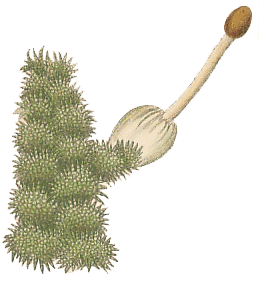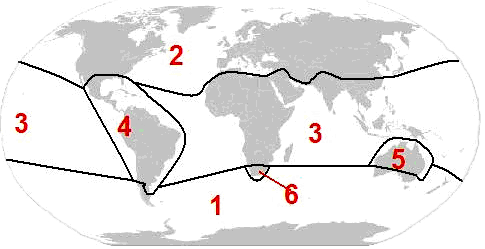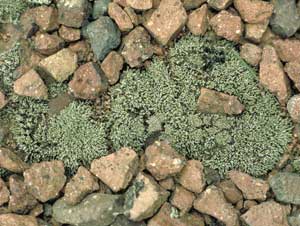
Bryogeography
Introduction
Biogeography is the study of both the current distribution of living organisms and the reasons for those distributions. Bryogeography is the biogeography of bryophytes. Compared to our knowledge of (and the reasons behind) the current world distribution of animals and flowering plants, similar knowledge about bryophytes is often rather poor.
Bryogeography is a vast topic and this section of the website will, of necessity, present a fairly limited discussion. The AUSTRALIA and ELSEWHERE page looks at the relationships of bryophytes in Australia with those elsewhere in the world. This introductory page will cover some general issues and some of the sources given in the reference button will give you more information about global bryogeography![]() .
.
Bryophytes show a wide variety of distribution patterns – from very widespread to very restricted. Many of those patterns parallel those found for the flowering plants, which suggests very strongly that both groups of plants have been influenced by the same factors. However there are many bryophytes with considerably wider distributions than those found for any flowering plant and you'll see some examples a little later. Theodor Herzog (1880-1961) published the first detailed global bryogeographical study in 1926 and, at the coarsest level, he delimited six broad bryogeographical zones (or Kingdoms). These six zones, possibly with some minor variations, are still widely accepted and are shown on the following map![]() .
.

Southernmost is the Holantarctic Kingdom (1), composed of New Zealand and various sub-Antarctic islands and parts of each of Antarctica, Australia and South America.
At the other end of the globe is the Holarctic Kingdom (2) which comprises the temperate and boreal zones of the Northern Hemisphere.
In between those two the Paleotropical Kingdom (3) consists largely of the tropical and southern temperate parts of Africa and Asia.
Each of the three kingdoms already listed extends considerably in an east-west direction. Of the remaining three the Neotropical Kingdom (4) has a considerable south-north extent, comprising the bulk of South America and extending into the south of the USA.
Australia, exclusive of the southern regions, makes up the Australian Kingdom (5) and southern Africa constitutes the South African Kingdom (6).
While these Kingdoms are a useful way of summarising the distributions of many bryophytes they don't tell the whole story. The boundaries between the Kingdoms are mostly rough lines on maps rather than physical barriers so, for example, it's not surprising to learn that bryophytes with Paleotropical affinities occur in northern Australia. Then there are the occasional differences of opinion. For example, some would extend the Australian Kingdom to include New Zealand. The majority of the six Kingdoms occupy large areas and are not bryologically homogenous. Bryologists have therefore created finer divisions within the kingdoms. In this introductory website we won't go into all the detail, but simply give a few examples. Within the Holarctic Kingdom the Pacific North American region comprises the west coast of North America. This area is bordered by two significant physical barriers – the Pacific Ocean to the west and the Rocky Mountains to the east. Looking close to home, Tasmania has considerable idiosyncrasies in both vascular plants and bryophytes that differentiate it from mainland Australia, from which it is separated by the physical barrier of Bass Strait. Eastern and western Australia are separated by large, dry areas (the Nullarbor Plain in the south and a series of deserts to the north). Looking at eastern Australia, the tropical rainforests along the coast of north Queensland have quite different characteristics to the temperate rainforests of the New South Wales south coast.
Finally, there are bryophytes which fall into none of the distribution patterns so far discussed. For example, the silvery-green moss Bryum argenteum and the thallose liverwort Marchantia polymorpha are cosmopolitan, being found on all continents (even the ice-free parts of Antarctica). The leafy liverwort Ptilidium ciliare is widespread through the Holarctic but is also found in New Zealand and the extreme south of South America. This is an example of a bipolar species, found in the north of the Northern Hemisphere and in the south of the Southern Hemisphere![]() .
.
Different species have different distribution patterns and you've just seen that with the examples of Bryum argenteum, Marchantia polymorpha and Ptilidium ciliare. Instead of looking at the species level you could also look at bryogeography at the genus level. You'll find that some genera are cosmopolitan, some are restricted to the Holantarctic and so on. Note that while a genus may be widespread, not all the species in the genus need be and it can be instructive to look at BRYOGEOGRAPHY AT DIFFERENT LEVELS.
Influences governing species distributions
Factors such as soil or rock type, rainfall pattern, humidity levels, temperature ranges and plant community composition help determine which bryophytes will be found in a given area. Climate changes, tectonic movements and human migrations are some other factors that have worked in the past to influence current species distributions. There's some more on this topic on the WHAT GOVERNS SPECIES' DISTRIBUTIONS? page.
The fundamental requirement
Comprehensive and accurate lists of species for different areas of the world are a fundamental requirement for any detailed bryogeographical analysis. Without such information you lack the sound basis for any bryogeographical hypotheses and, at best, can present only unsupported speculations. Yet, many areas of the world are still largely unexplored from a bryological point of view so that only inadequate species lists are possible. Even when areas have been bryologically explored to a reasonable degree, there is still the question of the accuracy of the names applied. The latter half of the 1800s and the early 1900s saw the naming of numerous non-European specimens, mostly by Europeans who did not set foot outside Europe. A significant amount of this work must be treated with scepticism since numerous "new" species were created on flimsy evidence. The opposite has also happened, where what really are new species were thought to be already-known species. It is clear that uncritical acceptance of such older work would lead to very misleading ideas about the distributions of species.
The 20th century saw a very wide variety of tools and techniques applied to the study of bryophytes. Examples of these are: laboratory studies of growth from spore to gametophyte and sporophyte, field studies into bryophyte ecology, chemical analyses, study of micro-morphology by electron microscopes and the use of DNA and RNA sequences. These have resolved many of the questionable species but it can take considerable work to sort out such problems and there are still many questionable species that need investigation. All bryogeographical statements are simply hypotheses based on existing knowledge and, not surprisingly, quite different ideas or problems may arise in the light of new evidence. You can find out more by reading OLD LITERATURE AND NEW IDEAS.
Tools and hypotheses
There are various tools that bryologists can use to produce the accurate species lists mentioned in the last section. Fundamental to anything are specimens, which can only be gathered by field work, ideally in all areas of the world. However, there are still parts of the world that are poorly known from a bryological point of view. Then comes the analysis of those specimens to determine which species they belong to. Over the past couple of centuries such analysis has involved a wide variety of techniques and examination of aspects such as macroscopic and microscopic morphology, ecological requirements, life-cycles, internal chemistry and, most recently, DNA or RNA.
Once there are good species lists it is possible to start formulating bryogeographical hypotheses. Any such hypothesis is a work-in progress, always liable to revision in the light of new evidence. As more areas of the world have been explored bryologically and as new analytical techniques have developed, bryogeographical ideas have changed and new questions have arisen.
There's some more about the subject in the TOOLS AND HYPOTHESES page.
Healthy scepticism
|
By now it should be clear that healthy scepticism is a useful asset in bryogeography. Most bryogeographical statements are based on assumptions of one sort or another. That is inevitable given the imperfections in our knowledge, so you should always look for the assumptions behind any bryogeographical claim. Healthy scepticism is especially useful when you come across an odd point on a distribution map. In many cases it will be a valid observation, supported by irrefutable evidence. But it may indicate the unthinking acceptance of unreliable literature. Also, and inevitably, mistakes will happen. Specimens may be mis-identified and surprising geographical errors do occur.
A description of the moss Brachymenium lanceolatum (right) was first published in 1859, ostensibly based on a specimen collected by Ronald Gunn in Tasmania. No further specimens of this moss have ever been collected in Australia and the only other collections are from India. Joseph Hooker, one of the authors of the original description was director of the Royal Botanic Gardens, at Kew in London, and had a voluminous, worldwide correspondence – with Gunn being one of those correspondents. It is possible that the supposed Tasmanian specimen is in reality an Indian specimen that had somehow mistakenly been ascribed to Gunn and Tasmania![]() .
.
In Oxford , England , there's a specimen of the moss Leucobryum candidum that was collected by William Dampier in 1699. The collection is labelled "New Holland", an old name for Australia, and Dampier did collect plants from two or three sites along the Western Australian coast. However, given the nature of those sites and the habitat preferences of the moss it is very unlikely that Dampier collected it in Australia. It was probably collected later in his voyage in Timor or New Guinea. The details are in the DAMPIER'S LEUCOBRYUM CASE STUDY.
A paper published in 1934 recorded the leafy liverwort Mastigolejeunea anguiformis for Australia. The herbarium specimen on which this report was based bore the following locality information on its label " Australia, Great Barrier Is." and was collected by Thomas Kirk. The Great Barrier Reef is Australian, but the Great Barrier Island is part of New Zealand and lies north-east of Auckland. Thomas Kirk (1928-1898) collected in New Zealand but there is no evidence that he did so in Australia. There is no other evidence for the occurrence of this liverwort in Australia so in this case the supposed Australian occurrence was due to a geographical error on the label of the herbarium packet![]() .
.
There's more!
The following pages look at various aspects of the bryogeography of the bryophytes found in Australia.
Many of the bryophytes found in Australia are also found in other parts of the world. This page looks at some examples.
This page looks at some species known only from Australia.
On this page you'll see examples of distributions that look puzzling. In some instances the puzzles are simply an indication of insufficient study, but in others the puzzles seem deeper.
Overseas bryophytes have been introduced to Australia and Australian species have found their way overseas.
![An Australian Government Initiative [logo]](/images/austgovt_brown_90px.gif)


